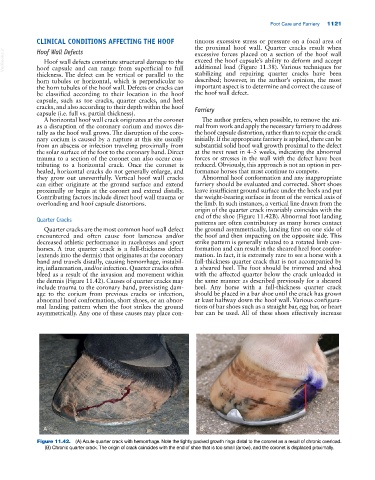Page 1155 - Adams and Stashak's Lameness in Horses, 7th Edition
P. 1155
Foot Care and Farriery 1121
CLINICAL CONDITIONS AFFECTING THE HOOF tinuous excessive stress or pressure on a focal area of
the proximal hoof wall. Quarter cracks result when
VetBooks.ir Hoof wall defects constitute structural damage to the exceed the hoof capsule’s ability to deform and accept
Hoof Wall Defects
excessive forces placed on a section of the hoof wall
additional load (Figure 11.38). Various techniques for
hoof capsule and can range from superficial to full
thickness. The defect can be vertical or parallel to the stabilizing and repairing quarter cracks have been
horn tubules or horizontal, which is perpendicular to described; however, in the author’s opinion, the most
the horn tubules of the hoof wall. Defects or cracks can important aspect is to determine and correct the cause of
be classified according to their location in the hoof the hoof wall defect.
capsule, such as toe cracks, quarter cracks, and heel
cracks, and also according to their depth within the hoof Farriery
capsule (i.e. full vs. partial thickness).
A horizontal hoof wall crack originates at the coronet The author prefers, when possible, to remove the ani
as a disruption of the coronary corium and moves dis mal from work and apply the necessary farriery to address
tally as the hoof wall grows. The disruption of the coro the hoof capsule distortion, rather than to repair the crack
nary corium is caused by a rupture at this site usually initially. If the appropriate farriery is applied, there can be
from an abscess or infection traveling proximally from substantial solid hoof wall growth proximal to the defect
the solar surface of the foot to the coronary band. Direct at the next reset in 4–5 weeks, indicating the abnormal
trauma to a section of the coronet can also occur con forces or stresses in the wall with the defect have been
tributing to a horizontal crack. Once the coronet is reduced. Obviously, this approach is not an option in per
healed, horizontal cracks do not generally enlarge, and formance horses that must continue to compete.
they grow out uneventfully. Vertical hoof wall cracks Abnormal hoof conformation and any inappropriate
can either originate at the ground surface and extend farriery should be evaluated and corrected. Short shoes
proximally or begin at the coronet and extend distally. leave insufficient ground surface under the heels and put
Contributing factors include direct hoof wall trauma or the weight‐bearing surface in front of the vertical axis of
overloading and hoof capsule distortions. the limb. In such instances, a vertical line drawn from the
origin of the quarter crack invariably coincides with the
end of the shoe (Figure 11.42B). Abnormal foot landing
Quarter Cracks
patterns are often contributory as many horses contact
Quarter cracks are the most common hoof wall defect the ground asymmetrically, landing first on one side of
encountered and often cause foot lameness and/or the hoof and then impacting on the opposite side. This
decreased athletic performance in racehorses and sport strike pattern is generally related to a rotated limb con
horses. A true quarter crack is a full‐thickness defect formation and can result in the sheared heel foot confor
(extends into the dermis) that originates at the coronary mation. In fact, it is extremely rare to see a horse with a
band and travels distally, causing hemorrhage, instabil full‐thickness quarter crack that is not accompanied by
ity, inflammation, and/or infection. Quarter cracks often a sheared heel. The foot should be trimmed and shod
bleed as a result of the invasion and movement within with the affected quarter below the crack unloaded in
the dermis (Figure 11.42). Causes of quarter cracks may the same manner as described previously for a sheared
include trauma to the coronary band, preexisting dam heel. Any horse with a full‐thickness quarter crack
age to the corium from previous cracks or infection, should be placed in a bar shoe until the crack has grown
abnormal hoof conformation, short shoes, or an abnor at least halfway down the hoof wall. Various configura
mal landing pattern when the foot strikes the ground tions of bar shoes such as a straight bar, egg bar, or heart
asymmetrically. Any one of these causes may place con bar can be used. All of these shoes effectively increase
A B
Figure 11.42. (A) Acute quarter crack with hemorrhage. Note the tightly packed growth rings distal to the coronet as a result of chronic overload.
(B) Chronic quarter crack. The origin of crack coincides with the end of shoe that is too small (arrow), and the coronet is displaced proximally.

